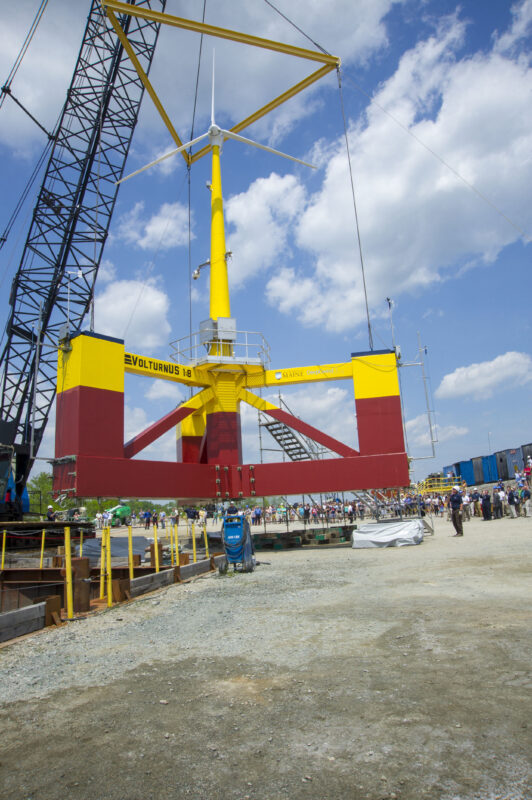Support CleanTechnica’s work through a Substack subscription or on Stripe.
The floating offshore wind industry is poised for growth with advancing technologies and expanding commercial projects. Due to the Trump administration’s rejection of renewable energy, however, offshore wind proposals in the US seem on first glance to be fraught with uncertainty. Maine’s offshore wind industry is moving along nicely, though, even if that’s not what you’re hearing in the legacy media.
In fact, Jack Shapiro, climate and clean energy director for the Natural Resources Council of Maine, wants to set the record straight and inform consumers about the facts of offshore wind in Maine.
The State of Maine Governor’s Energy Office proposed a 144 MW floating wind demonstration project and began contract negotiations with the state utilities commission in 2021. It was awarded a lease to 15.2 miles in the Gulf of Maine for the research array.
In October 2024, four commercial floating offshore wind leases were sold in the Gulf of Maine. Shapiro explains that this “exceeded expectations and served as a vote of confidence from developers in the long-term viability and promise of offshore wind in the Gulf of Maine.” Interestingly, political uncertainty hovered in the background at the time, as the lease sale took place days before the 2024 Presidential elections.
What was well-established was commercial offshore wind lease areas in the Gulf of Maine are more than 50 miles from the mainland at their nearest point, will not be visible from shore, and will have no impact on property values.
Leave The Lights On, Won’t You?
Responsibly developed offshore wind has the potential to be a big boost to Maine’s economy and local communities, Shapiro argues, and aligns with Maine’s more than 400-year maritime and shipbuilding heritage. Why is this important? Well, for many reasons, but of particular interest is the fact that utility bill savings will be passed through to Maine electricity customers.
It makes sense that Maine’s offshore wind perceptions are largely framed by principles of distributive justice, highlighting the need to ensure that the benefits and burdens of its development are equitably shared across Maine’s waterfront communities. If there is one blatant disconnect between the Trump administration’s dismissal of wind energy, it’s the fact that moves to stall progress on offshore wind lead to higher electricity prices.
For example, the State of Connecticut estimated that the Trump Administration’s plan to cancel Revolution Wind, which is already 80% completed, would cost electricity customers across New England, including Maine, $500 million per year in higher supply costs.
A study released in September 2025 showed that offshore wind power would generate massive savings during high-demand periods, lower New England electricity prices by 11%, and deliver $400 million in wholesale market savings in just three winter months.
An independent study from May 2025 showed that an offshore wind port in Maine would support more than 6,000 jobs during construction, an average of nearly 1,000 jobs annually through 2050, and deliver total economic benefits of $6.6 billion. That’s why support for a new offshore wind industry spans from the Maine State Chamber of Commerce to Maine’s labor unions.
Go, Fish
Creating clear understandings about potential impacts Maine’s offshore wind infrastructure to the state’s fishing industry offshore “is essential,” Shapiro says, “so any emerging impacts can be first avoided, then minimized or mitigated.” He suggests the best way to avoid impacts is to locate turbines away from prime fishing grounds.
Multi-constituent, non-partisan advocacy worked to pass Maine’s 2023 offshore wind bill, which required that projects not be placed in federal Lobster Management Area 1, where nearly all of the Maine-based lobster fleet fish. The provisions in the bill, plus bipartisan support from Maine’s Congressional delegation and the Mills Administration, led to the federal government excluding LMA1 from commercial offshore wind leasing, a big step toward allowing both clean energy and a vibrant fishing industry to exist in the Gulf of Maine at the same time.
Protect The Maritime Ecosystem
Climate change is the greatest threat facing the more than 3,000 marine species and birds in the Gulf of Maine, Shapiro outlines, and the best solution to the existential crisis is to replace polluting fossil fuels with cleaner energy sources like wind. “Using the best data and scientific research available, offshore wind projects in the Gulf of Maine will be held to the highest standards for siting and operations to protect ocean wildlife and ecosystems,” he says. “Developers will be required to include strong protections for wildlife and the ocean environment for both construction and operations.”
In response to pervasive misinformation about whale mortality, Shapiro reminds us that there is no scientific evidence linking offshore wind and whale deaths. He explains that the greatest risks whales face are actually, “vessel strikes, shifting food species due to climate change, and entanglement with fishing gear.” He continues that there is clear evidence, though, that links anti-offshore wind groups, misinformation about whale deaths and offshore wind, and fossil fuel-funded think tanks.
What fossil fuel companies want their customers to forget is that studies have shown that clean energy has substantially lower lifetime greenhouse gas emissions than fossil fuels. Including materials, construction, fuel, and decommissioning, wind power:
- emits 37 times less greenhouse gases per unit of power generated than natural gas
- discharges 77 times less greenhouse gases than coal
- the existing fossil fuel system is much more dangerous to human health and climate than wind
Final Thoughts
It’s been well-documented that opponents of clean energy spread misinformation, which leads to “widespread confusion” and fails to address “energy affordability issues facing Maine families every day,” Shapiro states. As early as 2023 it was clear that fossil fuel interests were working with climate denial think tanks and community groups to obstruct offshore wind projects.
The Gulf of Maine has some of the strongest and most consistent winds in the world, making it the most abundant and promising clean energy resource available to us. Maine’s offshore wind industry will be replacing expensive oil-fueled power plants that are fired up during periods of high demand.
Rather than succumb to the vast amount of misinformation about Maine’s offshore wind, Shapiro asks consumers to “seek out information from trusted sources.” He suggests the best approach to social media stories about wind is skepticism. He adds:
We can’t keep relying on expensive fossil fuels to power our homes and businesses. Not only does it drive up electricity prices, it fuels climate change, which is making the storms and flooding harming our communities worse. Responsibly developing offshore wind will generate the large amounts of reliable domestic energy we need to power the future and help keep energy costs affordable.

Sign up for CleanTechnica’s Weekly Substack for Zach and Scott’s in-depth analyses and high level summaries, sign up for our daily newsletter, and follow us on Google News!
Have a tip for CleanTechnica? Want to advertise? Want to suggest a guest for our CleanTech Talk podcast? Contact us here.
Sign up for our daily newsletter for 15 new cleantech stories a day. Or sign up for our weekly one on top stories of the week if daily is too frequent.
CleanTechnica uses affiliate links. See our policy here.
CleanTechnica’s Comment Policy




